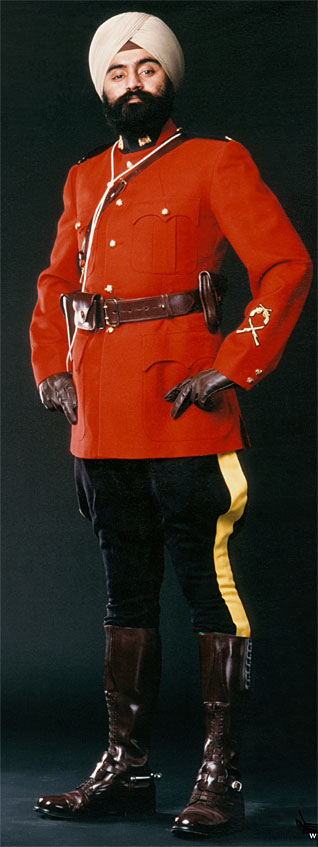 The rhetoric over the niqab in the federal election campaign is proving reminiscent of another furor, more than 20 years ago, around the Sikh turban and its compatibility with Canadian values and the country's dearest institutions.
The rhetoric over the niqab in the federal election campaign is proving reminiscent of another furor, more than 20 years ago, around the Sikh turban and its compatibility with Canadian values and the country's dearest institutions.What was allegedly at stake in that debate in the 1990s was the very fabric of the nation, and the sanctity and perhaps survival of an important historic symbol of the country -- the Stetson of the Royal Canadian Mounted Police.
Baltej Singh Dhillon, a young Sikh-Canadian, wanted to become a Mountie. But his application to the force led to a kind of turban turmoil and an eventual intervention in Parliament by the Progressive Conservative government of the day. [The ‘Progressive Conservatives’ were a completely different party from today’s ’Conservatives/Tories’; the latter, now led by Stephen Harper, is merely the reincarnation of the racist Reform Party which then led the fight to ban the turban.]
The debate was featured on newscasts and dominated the public conversation. Political parties took positions on it, including the Reform Party, which deemed allowing the right to wear a turban unnecessary, and went so far as to pass a resolution at its 1989 convention banning such religious attire for the RCMP. At the time, Stephen Harper was a defeated Reform Party candidate and the party's policy chief.
Baltej Singh is now a staff sergeant in the RCMP. The force refused to allow him to speak to CBC News about the turban debate. But in a video story produced by Telus Optik in B.C. and posted online, Baltej recalled the tone of the debate.
"It was vicious. It was angry. It was emotional. It had all the elements of racism in there. It was a disappointment is what it was," he said in the video.
"The fear was that we would lose the symbols that defined Canadians and defined our culture and defined who we were and our branding with the rest of the world."
"And that was the greatest irony: That on one hand, we need to protect our symbols, and in the same breath, we need you to not protect your faith or your religion or your roots."
CHANGE CAME IN 2011
That analysis points to parallels with Stephen Harper’s new crusade against the wearing of the niqab in citizenship ceremonies. The niqab has become a topic of debate due to the Harper Conservative government's legal battle with an Ontario woman over the right to wear the niqab during the public portion of the citizenship ceremony.
"Both the turban and the niqab are seen as religious requirements. So the link is obvious in my mind," says Natasha Bakht, law professor at the University of Ottawa, who studies the intersection of the Muslim face-covering and the law.
"We went through a situation where we were not used to seeing Sikh men. We were not using to seeing them on the streets, we were not used to seeing them in positions of authority, and usually when you're not used to seeing something, you are uncomfortable with it, or you are fearful of it. But we got past that."
Bakht believes discomfort is at the root of the debate about the niqab, too. She can find no legal argument to support its banishment, only an assessment the niqab is not necessary for Muslims -- and therefore, the right to wear it is not in need of protection.
Bakht says that position amounts to interference in the practice of faith. It supposes there is one correct, and state-sanctioned, interpretation of whether Muslim women ought to cover their faces.
But if one does imagine the assault on Canadian values allegedly posed by the niqab is a justifiable reason for restricting the wearing of the niqab when swearing the oath of citizenship, Bakht points out that has only recently been deemed a problem.
Until Jason Kenney announced the changes in 2011 when he was immigration minister, women were allowed to wear the niqab at those ceremonies, Bakht notes. It was Kenney's move that was the change.
Zunera Ishaq, an Ontario woman, challenged the ban in court and has had two rulings in her favour. The government has announced it will appeal the most recent ruling to the Supreme Court and is seeking a stay to prevent the niqab from being worn at citizenship ceremonies in the meantime.
CHARTER PROTECTION
The comparison between the niqab and the turban also resonates with Sukhpaul Singh, the vice-chair of the Canadian Sikh Association.
Opponents of the turban thought it unnecessary, or, at least, deemed the religion it represented not worthy of the protection the charter affords.
“They were using those religious symbols as a way to divide the communities, to divide our Canadian society and to challenge our values of tolerance," Sukhpaul Singh said.
He adds that the debates about the turban and now the niqab should not dissuade Canadians from pride in their acceptance of Canadians of other faiths and their faiths and traditions.
"You have to give Canadians a lot of credit," he said. "We're a tolerant society. And I think a lot of folks will see through this misinformation."
Original Article
Source: sikhchic.com/
Author: JAMES CUDMORE
No comments:
Post a Comment